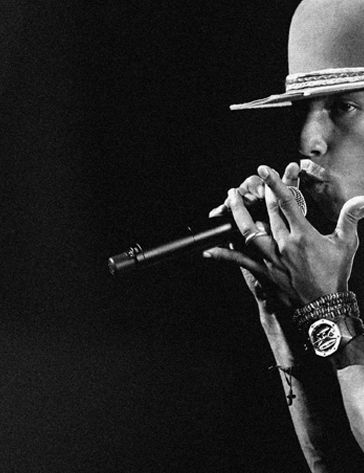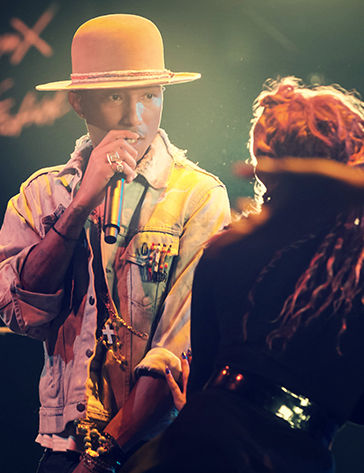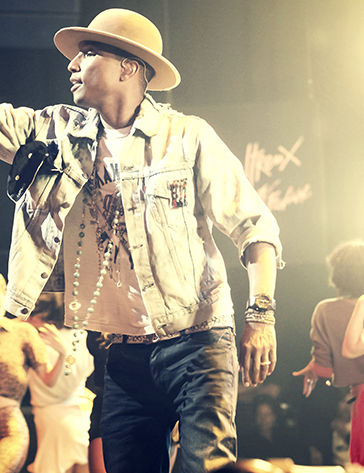Live engineers, Kyle Hamilton and Jeremy Peters, speak out about their working relationship with global superstar, Pharrell Williams, and how replicating the sound of his records on stage is absolutely essential...
Tell
me about your core FOH setup, Kyle – you seem to have screens
coming out of your ears...!
KH:
[laughs] I have a DiGiCo SD7, four
Avalon 737s, and then from my laptop I am running Logic with my
DiGiGrid MGB, and that’s it. But yes, I do have a few screens, as
there is so much going on; and you never know who’s going to make
an appearance, as Pharrell is producer of the stars, so anyone could
join him up there at any time. That’s why I choose an SD7 as my
console, because everything is possible, but it’s definitely a
controlled chaos situation! It’s quite a small band, but the way we
run it is like a symphony of sound. If you don’t do it the way that
Jeremy and I have strategically and formally laid it out... Well,
it’s not gonna work!
I
bought the latest Pharrell record, G I R L, and loved it. It’s an eclectic mix of all sorts of genres. Do you have to be
a fan of the music to work with it?
KH:
Definitely – you have to be
attached. We grew up on his music, and his catalogue is so large, you
have to study it. I mean, with any artist,
you have to listen to the music, and do your homework, but I remember
our first meeting with Pharrell, and he said, point blank, ‘people
want to hear the record’, so what that tells us is, we mix the
record with a live feel. So even if a band member might do a fill
here and there, nothing deviates much from what you hear on the CD.
There’s no doing your own thing or adding your own delays – if
it’s not part of that song, you don’t do it, because he wants it
true. When you watch him, and you see his neck start snapping, he’s
in his groove. That’s what he does in the studio, and that’s what
he does on stage. That’s when we know we’re doing it right!
Jeremy,
you must have your work cut out also. How does Pharrell like his
in-ear mix?
JP: What
we did on this gig was both fun and amazing – I use the DiGiGrid
MGB also, and Kyle and I multitracked every song every day, so when
the band leaves, we come back, and since he’s so serious about the
record, we took the live elements and the non-live elements, and did
an A-B test with the record, and made them perfect, so when Pharrell
hears Kyle’s
FOH mix, it’s the record – he’s also hearing those live
nuances, which he’s OK with, but he’s getting the record. He
feels like he’s in a studio, but with a live feel. He’s not one
of those artists that wants more vocal here, less of that here, and
so on; he wants to hear the whole mix, and rock out. He wants
consistency, and he wants people to get
it – this thing that he worked so
hard to produce. He already made it right, so you don’t have to
re-engineer it to make it right again.
Kyle,
are you using the processing from inside the console at FOH?
KH:
Yeah. If you think about it, everything
that Pharrell’s done has been recorded and mixed using Waves, so I
am already getting that true sound, so why re-invent the wheel?
There’s no need to try and get a nice round drum sound and augment
it, as it’s already there, so I just use some nice reverbs from the
console. For the Auditorium Stravinsky here, I don’t want it too
dry, so I add a little reverb, but only a little. There’s no need
to over-process the music, because once again, you’re changing his
vision – and it’s not about my vision, it’s about translating
his vision
to the stage.
JP: I use Waves a lot, but like Kyle says, you don’t have to process what’s already good, so I use it for effects: my reverbs on the background vocals, and on Pharrell’s vocal, too. I use the Waves kit to complement the sounds, give them a little bit extra here and there, but I never go overboard with it. Because I also work from an SD7, I have the luxury of quality dynamic processing and multiband compression, so I can take that from the desk, then use Waves for effects - it’s a great combination.
What’s
the vocal chain for Pharrell?
KH:
It’s a real simple chain, actually. I
go through an Avalon 737, and straight into the desk, where I do my
EQs and compression. Less is more, really, as that way, you’re
keeping true to his sound. Any effects that we use on his voice,
we’ve already done in Pro Tools and married to the desk, so we
always guarantee a consistent show. Whether we do the smallest
backyard boogie or the biggest stadium, we always have the same
consistent audio sound. If he does a little four-channel show for
somebody’s birthday party, he wants the same sound as he’d have
on a big stage. There’s no middle ground here! We’ve done those
kind of shows, when our consoles have been an iPad interface with
faders, our PA is on sticks, and we’re in a backyard... And his
in-ears had to feel like an arena or a stadium. You have to plan
ahead, because if you wait until the last minute, you fail.
JP: We’re using JH Audio JH16s, which sound phenomenal, especially as we’re running at 96kHz. My stage is pretty insane; every musician has a discrete sub of their own, and we always have a big sidefill system, but we don’t turn it up very loud - it’s just for a feel, and for the dancers to hear; that allows them to hear everything perfectly and feel the music. I can then keep the stage volume pretty low, so it doesn’t kill Kyle at FOH. The first time I put the JH16s in, I was amazed by the low end - I’d never heard low end out of an in-ear like that before. Jerry Harvey is definitely doing something very special!
Is
there a magic moment that stands out for you guys, or does every day roll
into one?
KH:
I
can’t say that any magical moment stands out, as every artist has
one at some point in their career. I would say my career
has
been magical - my 21 years in the biz. Being able to work with
artists at the top of their game, like Pharrell, and also those who
are today’s opener and tomorrow’s headliner. That’s what I
love. I remember doing shows in a mall, and now we’re rocking in a
100,000-seater stadium; and knowing you’ve grown together is really
something.
JP: I’ve
worked with so many artists in many genres, and it’s always the
same: people are people. It’s all about relationships, and if you
make them, you never lose them. Those are what make your life great.


